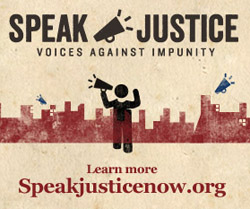The tortured and decapitated body of 39-year-old María Elizabeth Macías Castro was found on a Saturday evening in September 2011. It had been dumped by the side of a road in Nuevo Laredo, a Mexican border town ravaged by the war on drugs. Macías, a freelance journalist, wrote about organized crime on social media under the pseudonym “The Girl from Laredo.” Her murder, according to the Committee to Protect Journalists, was the first in which a journalist was killed in direct relation for reporting published on social media. It remains unsolved.
A total of 28 journalists have been killed for their work in Mexico since 1992, when CPJ began compiling detailed records on journalist deaths. Only three were killed while on dangerous assignments. The rest were targeted and murdered–many of them kidnapped and tortured as well–in retribution for their work. Half died during the six-year tenure of former President Felipe Calderón Hinojosa. In only a handful of these cases has there been justice of any kind.
But impunity in journalist murders is not unique to Mexico. Around the globe, more than 660 reporters, editors, photographers, and cameramen have been murdered, and in 90 percent of their cases, no perpetrator has been brought to justice. Conflict-ridden Iraq and Somalia have the highest impunity rates. They are closely followed by the Philippines, Pakistan, Russia, India and Brazil, among other democracies. The beats most often covered by murdered journalists–politics, corruption, conflict, crime, and human rights–are all issues of vital concern to any citizen.
In places where censorship-by-murder is common, the killers’ message is simple: Be silent or die. And in many instances, this message is echoed by local authorities that lack the capacity, or will, to find and punish perpetrators, and to protect journalists who are still alive.
This cycle of fear fosters silence. It nurtures self-censorship. It weakens the ability of the press to hold governments to account, and to keep citizens informed. In northern Mexico, where Macías lived and reported, organized crime groups have terrorized the press. The rule of terror and violence, combined with the perception that authorities are powerless, has pushed Mexican journalists into widespread self-censorship on crime, corruption, and violence.
But the cycle of silence and fear can be broken. Today, CPJ in collaboration with global and local partner organizations is launching a new digital campaign, Speak Justice: Voices Against Impunity, to demand justice for journalists murdered and protection for those still working to get us the news.
The campaign’s dedicated website, www.speakjusticenow.org, features interactive maps and an infographic video that allow users to explore the places where journalists are being murdered, and the issues that they were killed for: politics, corruption, conflict, crime, and human rights. Participation in the campaign allows e-advocates to speak up against the cycle of impunity by sharing up-to-date news, data and specific messaging on social media. Our collective goal is to achieve justice and better protection for journalists, like Macías, working hard to get us the truth.
This week, as new Mexican President Enrique Peña Nieto settles into office, Speak Justice advocates will call on him to bring to justice all those responsible for the 28 murders of Mexican journalists, including Macías. Next week, on December 9, International Anti-Corruption Day, advocates will spread the word about the 190 journalists murdered for their investigations into corruption worldwide. And on Human Rights Day, December 10, they will join the global call for human rights, reminding the world that we share a collective right to information, one that is taken from us when journalists are murdered. Join us, speak justice.
